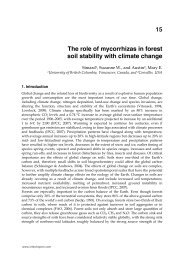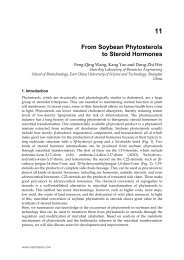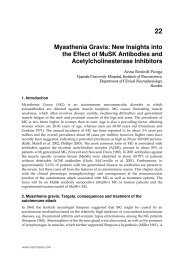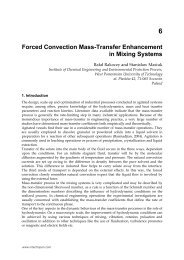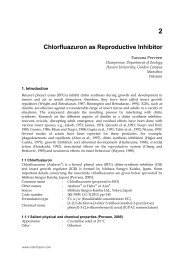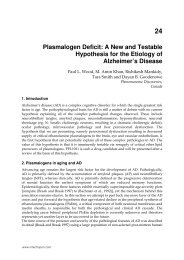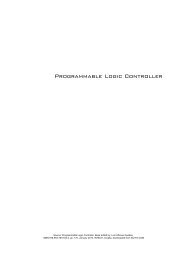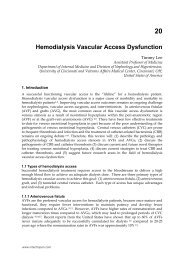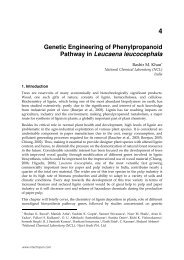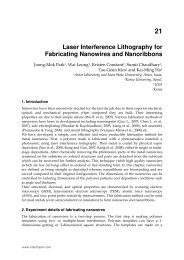Quality Control of Cordyceps sinensis Teleomorph ... - InTech
Quality Control of Cordyceps sinensis Teleomorph ... - InTech
Quality Control of Cordyceps sinensis Teleomorph ... - InTech
You also want an ePaper? Increase the reach of your titles
YUMPU automatically turns print PDFs into web optimized ePapers that Google loves.
230<br />
3. Results<br />
<strong>Quality</strong> <strong>Control</strong> <strong>of</strong> Herbal Medicines and Related Areas<br />
3.1 PCR amplification and DNA sequencing<br />
We amplified and sequenced the NS5/NS6 region and ITS region nrDNA sequences <strong>of</strong> the<br />
<strong>Cordyceps</strong> species collected in our laboratory. Their GenBank Accession Numbers<br />
(http://www.ncbi.nlm.nih.gov/) are provided in Table 1. The ITS region yielded products<br />
<strong>of</strong> approximately 550 bp, while those <strong>of</strong> the NS5/NS6 region were approximately 310 bp.<br />
In the present study, the 18S or ITS nrDNA sequences <strong>of</strong> the stroma and sclerotium (head,<br />
tail, and whole body) from each isolate were identical [Cs7528A(b) vs. Cs7528A(f); W1023(f)<br />
vs. W1023(t); Cs824a(f) vs. Cs824a(b); Cs7528H(f) vs. Cs7528H(h) vs. Cs7528H(t); Cs7528J(f)<br />
vs. Cs7528J(t); K1023(f) vs. K1023(h) vs. K1023(t); H1023(f) vs. H1023(t); T1023(f) vs. T1023(h)<br />
vs. T1023(t); S1023(f) vs. S1023(h) vs. S1023(t); Csd(f) vs. Csd(b); RSCsM(f) vs. RSCsM(h) vs.<br />
RSCsM(t); RSCsL(f) vs. RSCsL(h) vs. RSCsL(t); RSCsK(f) vs. RSCsK(h) vs. RSCsK(t); and<br />
RSCsI(f) vs. RSCsI(h) vs. RSCsI(t)] (Table 1). This result suggested that the stroma and<br />
sclerotium from each isolate originated from the same species.<br />
3.2 Phylogenetic analysis<br />
The phylogenetic tree based on the ITS region sequences is illustrated in Fig. 4. It was<br />
constructed using the sequencing data collected in this study as well as from GenBank. The<br />
C. memorabilis strain ATCC 36743 was set as the out-group. The 3 C. militaris sequences—<br />
GenBank Accession Nos. AJ242923, AJ243774, and CMC2—were grouped.<br />
The C. <strong>sinensis</strong> specimens could be divided into 5 subgroups. Group A included the<br />
following isolates: (1) Tibet isolates Cs824d(f), K1023(f), RS2, Csd(b), and Cs7528A(f) as well<br />
as those with GenBank Accession Nos. AJ243775, AJ243776, AJ243778, AJ243979, AJ243980,<br />
AJ245559, AJ413178, AJ413179, AJ413180, AJ507399, AJ507400, AJ507401, AJ507402, and<br />
AB067713; (2) Sichuan isolates Cs824a(f) and Cs824b(b) as well as those with GenBank<br />
Accession Nos. AJ413183, AJ413184, AB067715, and AB067717; (3) Qinghai isolates T1023(t)<br />
and those with GenBank Accession Nos. AJ413181, AJ413182, and AJ507404; (4) Yunnan<br />
isolates with GenBank Accession Nos. AJ309354, AJ309361, and AJ507403; (5) Gansu isolates<br />
with GenBank Accession Nos. AJ507405 and AB067716; and (6) uncertain locality isolates<br />
with GenBank Accession Nos. AB067718, AB067721, and AJ309357. This group is similar to<br />
subgroup 2 <strong>of</strong> Kinjo and Zang (2001), and the bootstrap level was 994.<br />
Group B included the following isolates: (1) Tibet isolates with GenBank Accession Nos.<br />
AB067739 (isolate Nyaramu-1), AB067740 (isolate Nyaramu-2), AB067743 (isolate<br />
Yagyusan), and AB067744 (isolate Satoku); (2) Sichuan isolates with GenBank Accession<br />
Nos. AB067742 (isolate Ritan), AB067745 (isolate Kandin Clone A1), AB067746 (isolate<br />
Kandin Clone A2), AB067747 (isolate Kandin Clone A4), AB067748 (isolate Kandin Clone<br />
B3), and AB067749 (isolate Kandin Clone B6); and (3) Qinghai isolate with GenBank<br />
Accession No. AB067741 (isolate Rusyasya). This group is close to subgroup 1 <strong>of</strong> Kinjo and<br />
Zang (2001), and the bootstrap level was 1000.<br />
Group C, which we discovered earlier (Chen et al., 2004), included the following: (1) Tibet<br />
isolate Cs1014C(b) and (2) Sichuan isolate W1023(f). The bootstrap level <strong>of</strong> Group C was<br />
1000. Although this group was remote from C. <strong>sinensis</strong> Groups A and B, the 2 isolates were<br />
identified to be C. <strong>sinensis</strong> based on morphological observations.<br />
Group D included the following isolates/strains: GenBank Accession Nos. AF122030 (strain<br />
BCRC 36421), AF291749 (strain MPNU 8002), and AB067720 (isolate SHANGHAI). The<br />
bootstrap level <strong>of</strong> Group D was 1000. Although these isolates were scientifically named C.<br />
www.intechopen.com




